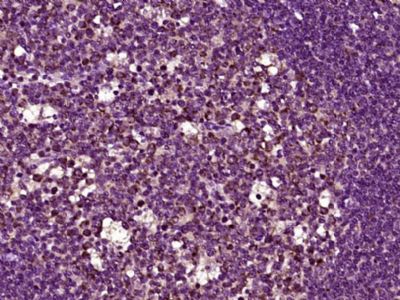GPBAR1 Polyclonal Antibody
Purified Rabbit Polyclonal Antibody (Pab)
- SPECIFICATION
- CITATIONS
- PROTOCOLS
- BACKGROUND

Application
| IHC-P, IHC-F, IF, ICC, E |
|---|---|
| Primary Accession | Q8TDU6 |
| Host | Rabbit |
| Clonality | Polyclonal |
| Calculated MW | 35 KDa |
| Physical State | Liquid |
| Immunogen | KLH conjugated synthetic peptide derived from human GPCR TGR5/GPBAR1 |
| Epitope Specificity | 5-100/330 |
| Isotype | IgG |
| Purity | affinity purified by Protein A |
| Buffer | 0.01M TBS (pH7.4) with 1% BSA, 0.02% Proclin300 and 50% Glycerol. |
| SUBCELLULAR LOCATION | Cell membrane. |
| SIMILARITY | Belongs to the G-protein coupled receptor 1 family. |
| Important Note | This product as supplied is intended for research use only, not for use in human, therapeutic or diagnostic applications. |
| Background Descriptions | The G protein-coupled receptor TGR5 is a 330-amino acid protein that is almost universally expressed in human tissues including heart, skeletal muscle, spleen, kidney, liver, small intestine, placenta, and leukocytes, but not in brain, colon (without mucosa), thymus, or lung. TGR5 is sensitive to bile acids and responds through a significant mechanism that coordinates energy homeostasis. Bile acids activate mitogen-activated protein (MAP) kinase pathways, specifically induce TGR5 internalization, promote an increase of guanosine 5'-O-3-thio-triphosphate binding in membrane fractions, and cause rapid intracellular cAMP production. Bile acids also provoke TGR5 to suppress macrophage functions. TGR5-controlled signaling pathways may be good candidates for drug targets to treat common metabolic diseases, such as obesity, type II diabetes, hyperlipidemia, and atherosclerosis. |
| Gene ID | 151306 |
|---|---|
| Other Names | G-protein coupled bile acid receptor 1, G-protein coupled receptor GPCR19, hGPCR19, Membrane-type receptor for bile acids, M-BAR, hBG37, BG37, GPBAR1, TGR5 |
| Target/Specificity | Ubiquitously expressed. Expressed at higher level in spleen and placenta. Expressed at lower level in other tissues. In digestive tissues, it is expressed in stomach, duodenum, ileocecum, ileum, jejunum, ascending colon, transverse colon, descending colon, cecum and liver, but not in esophagus and rectum. |
| Dilution | IHC-P=1:100-500,IHC-F=1:100-500,ICC=1:100-500,IF=1:100-500,ELISA=1:5000-10000 |
| Format | 0.01M TBS(pH7.4), 0.09% (W/V) sodium azide and 50% Glyce |
| Storage | Store at -20 ℃ for one year. Avoid repeated freeze/thaw cycles. When reconstituted in sterile pH 7.4 0.01M PBS or diluent of antibody the antibody is stable for at least two weeks at 2-4 ℃. |
| Name | GPBAR1 |
|---|---|
| Synonyms | TGR5 |
| Function | Receptor for bile acid. Bile acid-binding induces its internalization, activation of extracellular signal-regulated kinase and intracellular cAMP production. May be involved in the suppression of macrophage functions by bile acids. |
| Cellular Location | Cell membrane; Multi-pass membrane protein |
| Tissue Location | Ubiquitously expressed. Expressed at higher level in spleen and placenta. Expressed at lower level in other tissues. In digestive tissues, it is expressed in stomach, duodenum, ileocecum, ileum, jejunum, ascending colon, transverse colon, descending colon, cecum and liver, but not in esophagus and rectum |

Thousands of laboratories across the world have published research that depended on the performance of antibodies from Abcepta to advance their research. Check out links to articles that cite our products in major peer-reviewed journals, organized by research category.
info@abcepta.com, and receive a free "I Love Antibodies" mug.
Provided below are standard protocols that you may find useful for product applications.
If you have used an Abcepta product and would like to share how it has performed, please click on the "Submit Review" button and provide the requested information. Our staff will examine and post your review and contact you if needed.
If you have any additional inquiries please email technical services at tech@abcepta.com.













 Foundational characteristics of cancer include proliferation, angiogenesis, migration, evasion of apoptosis, and cellular immortality. Find key markers for these cellular processes and antibodies to detect them.
Foundational characteristics of cancer include proliferation, angiogenesis, migration, evasion of apoptosis, and cellular immortality. Find key markers for these cellular processes and antibodies to detect them. The SUMOplot™ Analysis Program predicts and scores sumoylation sites in your protein. SUMOylation is a post-translational modification involved in various cellular processes, such as nuclear-cytosolic transport, transcriptional regulation, apoptosis, protein stability, response to stress, and progression through the cell cycle.
The SUMOplot™ Analysis Program predicts and scores sumoylation sites in your protein. SUMOylation is a post-translational modification involved in various cellular processes, such as nuclear-cytosolic transport, transcriptional regulation, apoptosis, protein stability, response to stress, and progression through the cell cycle. The Autophagy Receptor Motif Plotter predicts and scores autophagy receptor binding sites in your protein. Identifying proteins connected to this pathway is critical to understanding the role of autophagy in physiological as well as pathological processes such as development, differentiation, neurodegenerative diseases, stress, infection, and cancer.
The Autophagy Receptor Motif Plotter predicts and scores autophagy receptor binding sites in your protein. Identifying proteins connected to this pathway is critical to understanding the role of autophagy in physiological as well as pathological processes such as development, differentiation, neurodegenerative diseases, stress, infection, and cancer.


